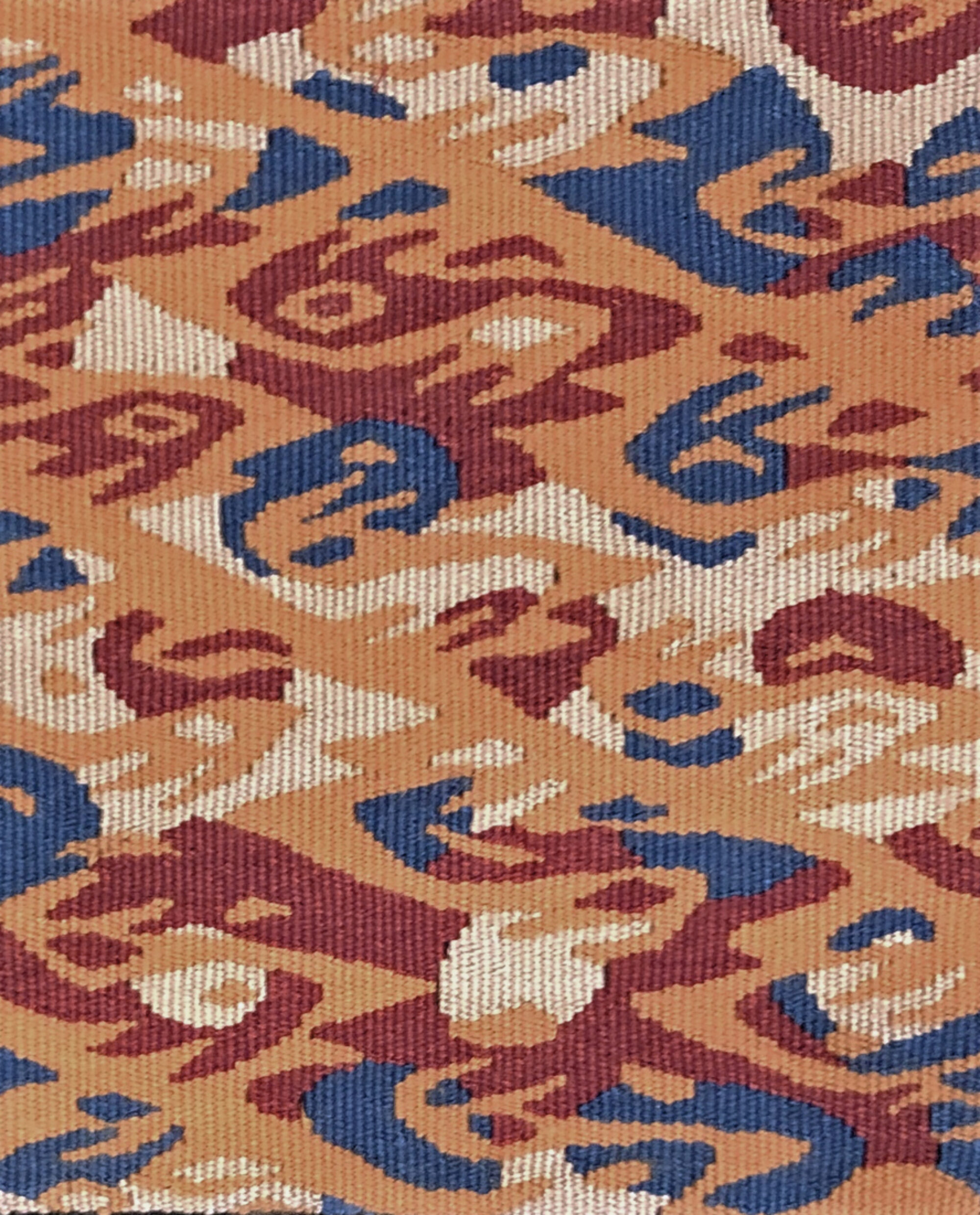In 2020 I extended this rumination on mark making into a talk for the Damascus School of Fiberarts fundraiser. You can listen to the talk here.
Terry Olson sent me an email in 2010, asking about mark making in tapestry. I posted it in a blog and several other people responded.
Terry Olson
“Several of us are having a discussion about mark-making. We have not had formal art training, so we looked up the term on the internet.
We found an ASU website page that told us: “If you distill the graphic arts (e.g., painting, drawing, printmaking, computer graphics, etc.) down to their most fundamental element, you find the mark. Marks are like building blocks in that they are individual and discrete, but can be used in a repetitive manner to render almost any visual effect. Marks can be highly gestural and expressive, or controlled and mechanical. The degree to which artists can achieve certain desired effects is determined by their choice of tool, the nature of the medium used, and the quality of the gestures employed. Marks can be descriptive, expressive, conceptual, and symbolic in nature.
One of us now thinks that tapestry doesn’t include mark-making because we don’t use gestures. I am wondering if you would mind contributing to this discussion with a brief answer to the question: ‘What is mark-making in tapestry?’”
Mary Lane
For just browsing on the internet, you came up with what I think is a good description of the mark.
I would say that in tapestry one could consider the mark on various levels,
- the individual intersection of warp and weft
- the pick (the weft going one direction through the warp)
- the pass (the weft going both directions through the warp)
So that is basically a dot, a dashed line and a line. These are the fundamental building blocks of tapestry weaving. From the repetition of these building blocks, shapes are created, and in some sense shapes like the square, the rectangle and the triangle can also be considered building blocks. Think of how Navajo designs are created by amassing squares, rectangles and triangles.
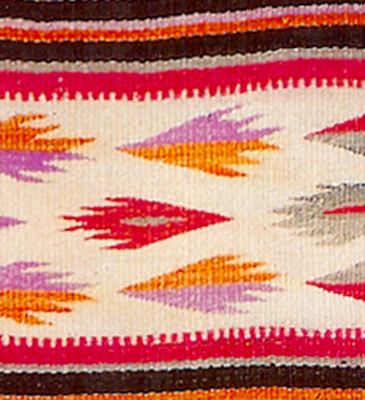
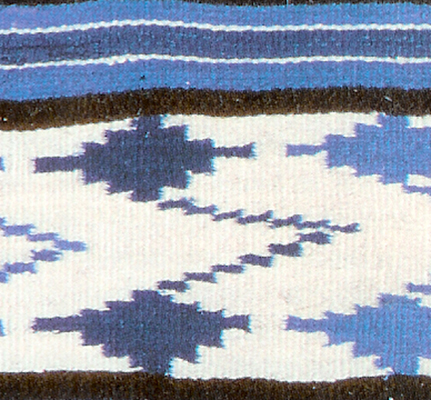
And look how in the Devonshire Hunting Tapestries, the shading in the garments is done by juxtaposing squares of light, medium and dark.

And in this detail from The Hunt of the Unicorn the shading is done with hachures, but if you look at a hachure it is really just an elongated triangle – thicker on one end and thinner on the other – and in some cases, tapering off to a half pass – the dashed line.

And then, if you let the geometry of the triangle or square waver a little you get grass, like this detail from The Devonshire Hunting Tapestries. Referring back to the definition you found on the web. This might be considered a more gestural use of the basic vocabulary of the grid that underlies the structure of the weave and the rendering of images in tapestry, compared to the Navajo use, which might be considered more mechanical. On the other hand the Navajo use of the tapestry language might be more symbolic, this use is in the service of a more literal image.
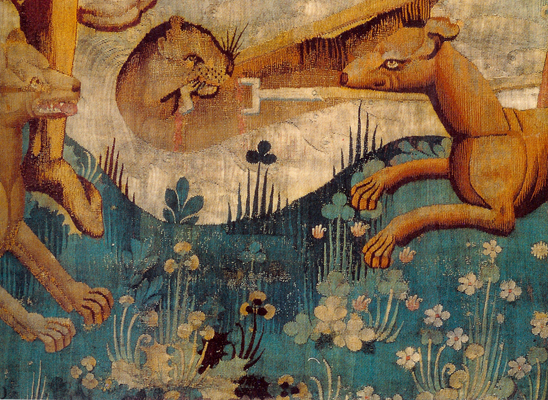
Another modification of the hachure to create the play of light across hair in the Hunt of the Unicorn.
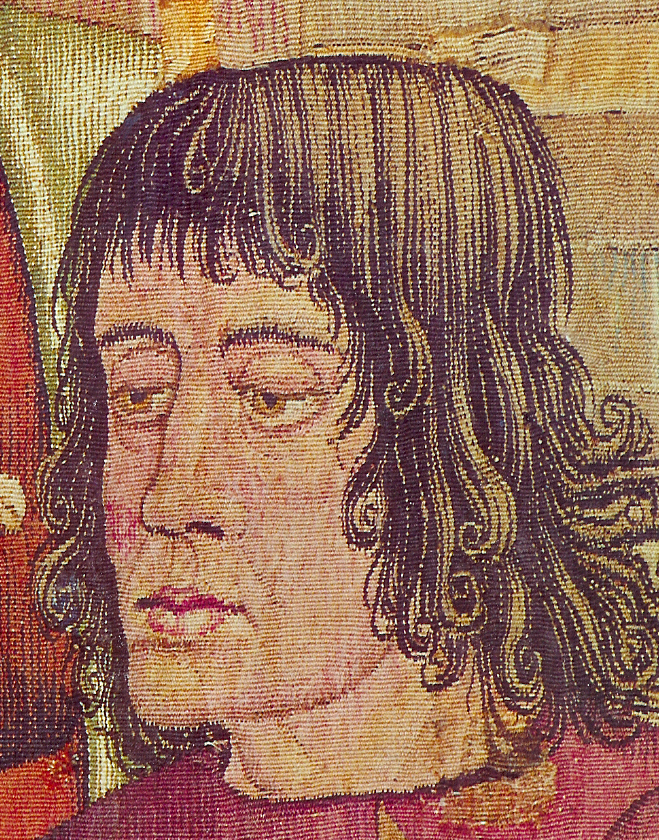
And, in contemporary weavers: Susan Martin Maffei is one person whose work reflects the basic marks of tapestry. Look at the compositional layout of this piece. It reinforces the geometry of weaving.
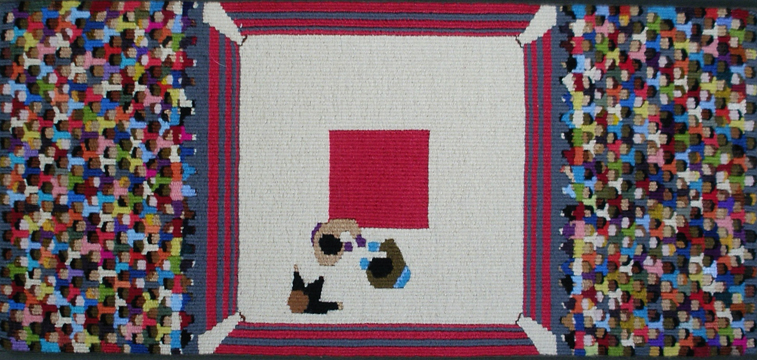
And now look at a detail of the crowd. I’ve turned it on its side here to fit the format of the page better. It is basically the repetition of a very limited vocabulary of form, with small variations in the shapes, to suggest things like people turning their heads. The variation in the color and value of the color is what it makes it so dynamic.
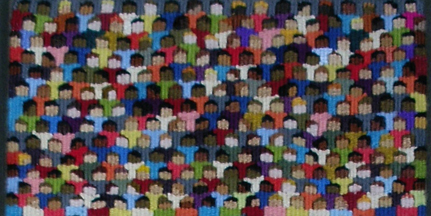
Compare the detail of the boxing match to a detail from this Andean textile.

Here is a piece by Silvia Heyden made up of stripes, lines of different thicknesses.

Here is a second Silvia Heyden tapestry and a detail of a third. She is developing modulations off the basic vocabulary of tapestry weaving.

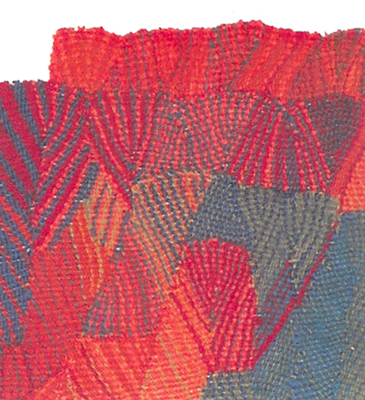
Dorothy Clews
I would like to add here that a kind of supplementary weft such as flying shuttle also can make a variety of marks, in any direction. Flying shuttle can be used for outlines, and internal fine lines within the woven shape or alternatively as in the images, as almost like a form of drawing.

Lyn Hart
Another contemporary weaver that came to my mind immediately is Michael Rohde. Many of his tapestries are based on repetitive shapes & forms that could be considered marks, such as this piece, “Fire, Earth, Air” & a detail of it…
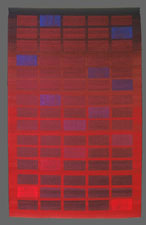
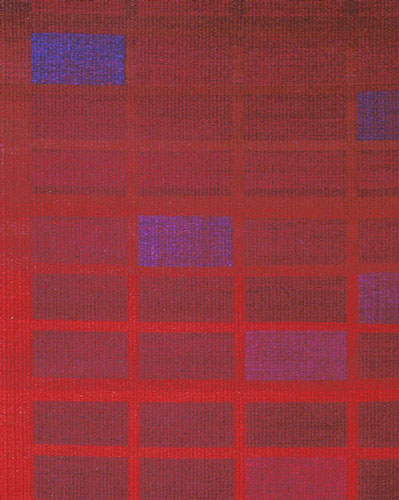
But I think his series “Houses for Nomads” really demonstrates the essence of mark making in tapestry–
“Houses for Nomads is a set of tapestries, created around the experiences of a month long trip to the Amdo and Kham regions, populated by the nomadic Tibetan yak herders. We visited small villages, nomadic encampments and were able to attend festivals that were led by shamans, celebrating their mountain gods and the coming harvest, as well as Nomad and Horse festivals. Most moving of all were the fields of prayer flags, placed where the wind would carry the printed prayers on, and left until they were threads, a moving acknowledgment of the impermanence of all things.” Michael Rohde
–especially one of the tapestries from that series, “Tibetan Prayers.”
Mary Lane
Looking at the detail of Michael Rohde’s work and the subtle modulations of the colors made me think of abrash – the color variation that is due to variation within the same dyebath – intentional or not. I wonder if that could be seen as a form of mark making in tapestry?
Tommye Scanlin
I think the quote Terry provided very much speaks to what one does when weaving tapestry. “…like building blocks in that they are individual and discrete…” — every individual pick of weft through the shed leaves a blip of weft covering a warp “… used in a repetitive manner….” as the weft covers every alternate warp in plain weave structure. “… the nature of the medium used…” certainly shows as the appearance of weft-faced, handwoven tapestry has a look like no other medium offers. Yes, maybe one has to give the object a very close observation to see that effect. That “Marks can be descriptive, expressive, conceptual, and symbolic in nature.” also very much applies to tapestry, I believe. A personal instance of that is in my tapestry diaries in which I use the pick to make a mark, sometimes combined with the second pick of a pass to make a line, or left as an individual mark on alternate warps, or combined in pick and pick–the choice of way it’d done depending on the day of the month being represented (symbolized) through the choice of mark made.
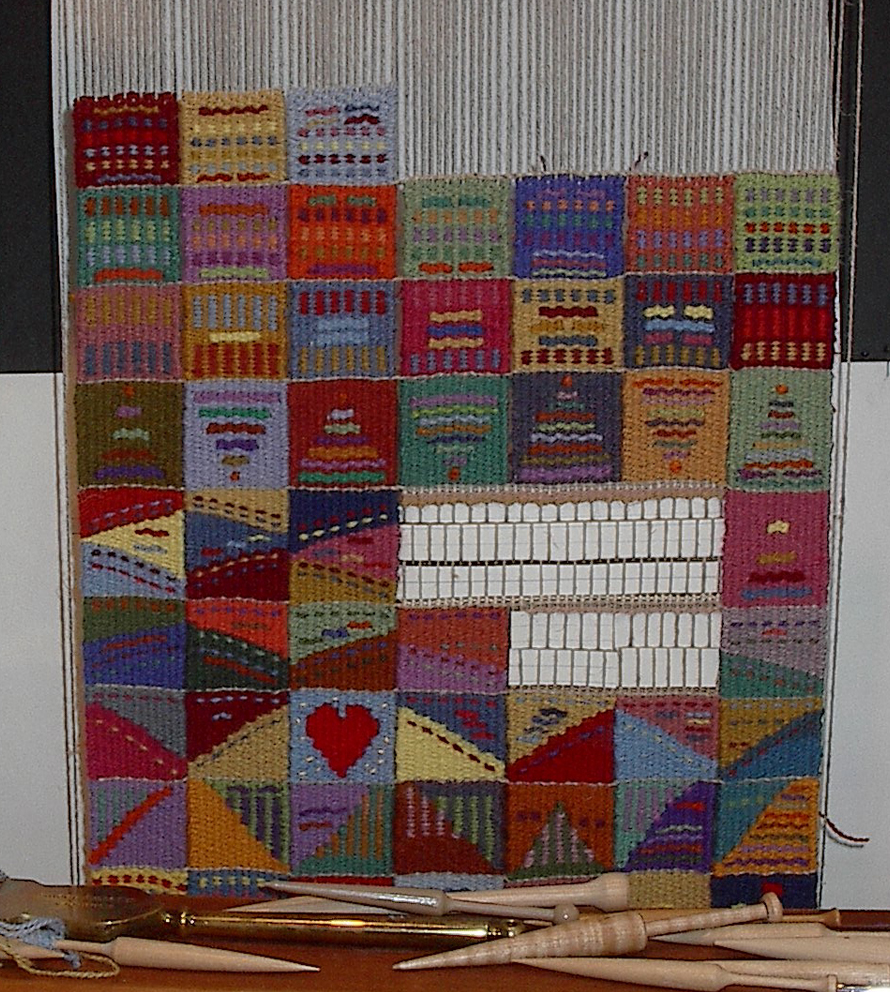
Unknown person
So then, if we knew the code, we could read the dates? And I guess since the units of weaving are sequential, we should be able to figure out the dates… And the space markers are days you didn’t weave?
Lyn Hart
I just read an Introduction to a catalog of drawings that I recently got and the author was repeating things you often read in essays about drawing – that it is the closest, most direct expression of the creative thought; that it has great potential for spontaneity and freshness; that you can see the mind at work in the marks made on paper (or whatever the substrate is). I was wondering how you all felt that kind of thinking about marks and directness relates to tapestry weaving, which has a much slower pace?
Kathe Todd-Hooker
I certainly feel that mark making may be done in tapestry. There is gesture in every trip of the weft through the warp. The result of the gesture depends upon the weft and its relationship to other wefts already in place. And, as the many examples you showed, Mary, and in Dorothy’s details of flying shuttle technique, the variety of that gesture can take it great.
Although not mark-making in particular, I’d like to put a link here to one of Marla Mallett’s articles–this one about the evolution of a motif: http://www.marlamallett.com/archetyp.htm. This relates to part of the definition for mark making that Terry gave, as “building block”–I think.
Mary Lane
I enjoyed the Marla Mallett article. About half way through the article she compares a knotted pile piece with a slit tapestry piece – both woven by the same person. She points out that the knotted pile piece has lots of verticals in the design and that the tapestry uses primarily diagonal lines. No slits form along a vertical color join in a knotted piece so it is structurally sound, whereas in a tapestry the slits along vertical color joins will end up being a structural weakness – even if they are sewn. How many of you think about these kinds of considerations – or think we should think about these kinds of considerations? I think this is something Muriel Nezhnie thinks about.
Linda Rees
Terry mentioned “One of us now thinks that tapestry doesn’t include mark-making because we don’t use gestures.” I like all of Mary’s examples of marks. I think about gesture as symbol, like the line that slightly bends near the top as symbol for grass or variously slanted and repeated, maybe like some of Julia Mitchell’s beach grasses. The definition in MS Word refers primarily to a motion that expresses meaning or emotion. I think the need to imply motion is critical to any two-dimensional art form and that it is an aspect that we spend a lot of time trying to perfect. It makes the images more believable, defines direction, a way the eye can translate the representation as a known experience whether landscape or figure.
Terry Olson
I totally agree that “the need to imply motion is critical to any two-dimensional art form”. When I read again that ASU definition, where they say marks can be gestural or controlled and mechanical, I think that tapestry we must do both. We seek the emotional gesture, that does as Linda suggests, but because of the nature of our medium, we have to do it in a controlled and “mechanical” way. It isn’t like splashing paint around willy-nilly, the yarn will go where it must.
Mary Lane
2020 Postscript. We should continue this conversation and see what our thoughts are now, a decade later…
